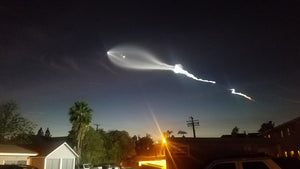The Great Conjunction 2020
The planets Jupiter and Saturn will make a close approach on 21 December, passing within 6.1 arcminutes of each other. This will be the closest approach of the two planets in the last 400 years, and a once-in-a-lifetime chance to see the two planets within the same telescopic field of view!
The last time the rare alignment of the planets was this close was in 1623. That was only 14 years after Galileo discovered the moons of Jupiter with the invention of the telescope. Astronomer, Johannes Kepler, speculated in 1614 that the alignment of the two planets might have been what was reported in the Nativity Story of Christ in the Bible. The planets aligned in 7 B.C., around the time that Christ was born.
Most of the time, when Jupiter overtakes Saturn (every 20 years or so), they usually are separated by more than a degree. But come Dec. 21, they will be separated by just about one-tenth of a degree or 6.1 arc minutes. From Los Angeles (check your location HERE), the pair will become visible around 17:04 (PST) as the dusk sky fades, 19° above your south-western horizon. They will then sink towards the horizon, setting 2 hours and 18 minutes after the Sun at 19:04. Here are some more expert tips to help you make the most of this event!
- Jupiter and Saturn will be easy to locate and be a noticeable pair as there are no other stars in the night sky that can outshine Jupiter. Jupiter will shine at magnitude -2.0, while Saturn will be much dimmer at +0.6. If you are a beginner and unfamiliar with the night sky, a planetarium app for your smartphone can help point the way. Some of the more robust apps like SkySafari and Celestron’s SkyPortal will also let you know what time the planets rise and set.
- Do not wait until December to begin watching Jupiter and Saturn. They are visible now! Take note of their positions and keep track of them as they move closer and closer together in the weeks leading up to their historic conjunction.
- A few days before the conjunction, note where Jupiter and Saturn are located near the southwestern horizon, so you will have an idea of where they will be on the night of December 21. This will enable you to select the best viewing location with a clear unobstructed view of the southwestern horizon.
- Set up early. There will only be a short window to see the event—about two hours.
- On the evening of December 16 and 17, the thin crescent Moon will be joining Jupiter and Saturn in the southwestern sky. Look for an enchanting evening display.
- Use a telescope at about 75x to 100x magnification or more to fit both planets along with their respective moons in the same eyepiece field of view. What a treat it will be to see the two most popular planets together at the same time in the same eyepiece! Please note that because Jupiter and Saturn will be relatively close to the horizon, the view may become somewhat distorted. After all, you will be observing the planets through the thickest part of Earth’s atmosphere.
- If you have access to a binocular or a spotting scope, use it! Any optical aide will enhance the planets for a more memorable viewing experience. Even a small 8x42 or 10x42 binocular will show Jupiter as a disc and reveal its four brightest moons! Unfortunately, the magnification will not be strong enough to reveal Saturn’s rings. Be sure to use a tripod if one is available to help steady the view, or use a table, wall, or automobile hood/trunk to prop up your arms to help minimize any shaking.
- If no optical aide is available, just use your unaided eyes and enjoy the view.
- Capture this historic moment with your camera! These planets will not be this close again until the year 2080. Because Jupiter and Saturn will be near the horizon, include a foreground subject for a more picturesque composition. Selfies, anyone?
- Once the historic Great Conjunction of Jupiter and Saturn is over, it does not mean you should stop observing. Continue to follow the planets, and you will gradually see them separate and slowly move apart as the nights go on.
OCtelescope







